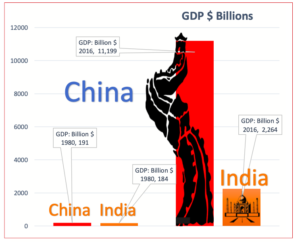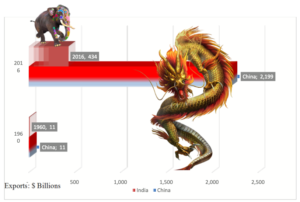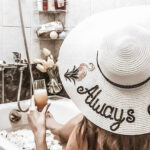India has exhibited, even during the Covid-19 calamity, how to organize for its own needs, while most countries were dependent on other nations. India aided 100 plus countries by providing medicines, and manufactured hundreds of thousands of N95 masks which were barely made in the past. When it comes to picking the best overseas manufacturer in Asia, two of the most common places for manufacturing are India and China. Both countries have very dynamic manufacturing capabilities and unique economic landscapes with proven skills, strengths and weaknesses that make both countries viable choices. However, India still lags far behind China in respect to manufacturing.

China and India are as different as chalk and cheese
India’s argumentative liberal democracy of 1.3 billion people with a massive ethno, linguistic, religious and cultural diversity is unparalleled in the world. India truly is an example for the rest of the world that a very large country with unimaginable diversity can still make significant development gains within a democratic set up. There is so much that is wrong in India, but one needs to accept that there is so much that is right.
In comparison, China has more of a social homogeneity and communist party-state system. The key factor that has allowed it to focus single-mindedly on growth. Indian former Prime Minister Manmohan Singh once said, there are “other values which are more important than the growth of the gross domestic product” and that “once a democracy decides on the basis of a wide-ranging consensus, any reforms that are undertaken will be far more durable, will be far more effective than reforms introduced by the writ of a ruling group in a non-democratic setup”.
Therefore, it is absolutely meaningless to compare the Indian and Chinese economies. China’s achievements have come through sacrifices of things which we in India take for granted. Should India make the same sacrifices and terminate things like free speech and multiparty democracy? Which I think would not be an advisable thing in present times. Let’s compare the two economies and their growth factors.
China overtook India in growth Early start and better decisions
Deng opened China up to the world, built up a manufacturing base, and achieved a nearly 10 per cent CAGR growth rate for the economy. China’s GDP was over $13 trillion in 2018, whilst India’s was $2.7 trillion, just under a fifth of China’s. The two main reasons for this differential is the early start by China and their more functional policy decisions.
In 1978 Morarji Desai was India’s PM, who, following India’s socialist bend, levied a 97 per cent income tax and a 3 per cent wealth tax, effectively killing enterprise and planting the seeds of rampant corruption. He was succeeded, briefly, by Charan Singh and later by Indira Gandhi, who was famous for bank nationalization (1969), introduction of MRTP (1969), FERA (1973) and coal nationalization (1973), again, killing private enterprise.
India’s Economic reforms 1991
The year 1991 has a special significance in the Indian economy. Economic measures were announced to achieve the objectives of higher growth. The economic reforms pointed at rapid industrialization. The government abolished industrial licensing, allowed foreign investment, encouraged the private sector along with the coexistence of public sector.
Physical infrastructure has a direct impact on the growth and overall development of an economy. While India is the fourth largest economy in the world, a key factor obstructing its growth and development is the lack of world class infrastructure. Fast growth of the Chinese economy in recent years indicate growth factors to good physical infrastructure, such as electricity, railways, roads, ports, airports, irrigation, water supply, and sanitation systems, all of which already suffer from a substantial deficit in India. Infrastructure development will also help create a better investment climate in India.
Chinese vs. Indian Growth story
In 1987, GDP of both countries was almost equal. But in 2019, China’s GDP is 4.78 times greater than India. China crossed $1 trillion mark in 1998 while India crossed 9 year later in 2007 at exchange rate basis.

China’s Economic Reforms, 1978-Present
Between 1949 and 1976, under Mao Zedong’s leadership, the Chinese Communist Party (CCP) implemented socialist economic policies. In the 1950s, China implemented the central planning of industry which was very similar to the five-year plans of the Soviet Union. Under this program, agriculture sector was collectivized, and the stress was on heavy industry. In December 1978, Deng Xiaoping came to power and introduced the famous four-character policy GaigeKaifeng, which was a reform of the economic system and it opened the Chinese economy to the outside world. Under this policy – Gaige Kaifeng,China began moving away from a centrally planned economy towards a market-oriented system.
China succeeded in demolishing of central planning system inindustry, striking the de-collectivization of agriculture and the most importantly opening-up phase which led to China’s entry into the World Trade Organization (WTO) in 2001. It is very much evident that the reforms have stemmed in swift economic growth of China.Yet, one cannot deny the fact that in the early 21st century many Chinese people lingerto be gravely poor, though the reforms remain to be unfinished and debatable.
China’s Success Factors
China primarilyfollowed an export-oriented track to industrialization, comparable to the four Asian tigers—Hong Kong, Singapore, South Korea and Taiwan. However, since the past decade China began to expand into other sectors of the economy.
The key factors identified by many economists, that are responsible for China’s economic success are
Authoritarian Government,
Strong Leadership,
Labor Supply,
Women Workforce,
Export-Led Growth.
Authoritarian Government Influence
The Communist rule formed the culture and labor force of China. Since 1949, China has been a socialist nation andthe government has played a major role in the economic structure. The Chinese governmentowned almost all of the manufacturing organizationsin the industrial sector. Meanwhile, in the urban sector the government controlled financial policy, the banking system, controls the distribution of investments, set the prices for key commodities, advisedthe productivity targets for keyestablishments, fixed wage levels, runs the wholesale, distribution and retail networks. The Chinese Communist Party reserves the right to make broad decisions on economic policies and the State Council actsand takes the major burden of running the economy.
Investment in Capital (machinery, technology, infrastructure)
Research on China’s economic development has hinted animportant role for capital investment in economic growth, and a substantialshare of China’s growth is in fact attributable to capital investment that has made the country more productive. Creating a world class infrastructure, investing in latest machinery and better technology has assisted in increasing China’s industrial output. It is evident that higher productivity has helped China achieve this new level of economic status. In commercial fields, too, China’s larger economy gives it resources to develop technologies.
Productivity boom
Since 1979, China shifted gears of economic reforms, the central government-initiated pricing and ownership incentives for farmers. This reform permittedfarmers to sell a portion of their crops on the free market. The Chinese government also established four special economic zones along the coast with the purpose of boosting exports and attracting foreign investment.
Freeing of enterprises from state intervention
The Chinese government gave economic control of various organizations to state and local governments. These organizations were generally allowed to operate and compete on free market principles, rather than under the direction and guidance of state planning.Few reformsfollowed in stages, which sought to decentralize economic policymaking in several sectors, particularly trade.
Foreign investment in China
In the first half 1990s, China’s trade and investment reforms, particularly the incentives offered, lured investors and led to a flow in FDI. These investment flows have been a key source of China’s productivity advantagethat resulted in a speedy trade growth. Local Citizens were encouraged to start their own businesses. Coastal regions and cities were chosen as development zones, which permitted them to test with free-market reforms and to offer tax and trade incentives to attract foreign investment. Also, state price controls on a varied range of products were regularlyreduced. Trade liberalization was also a foremost key to China’s economic achievement. Removing trade barriers refreshedbigger competition and attracted FDI inflows.
Strong export growth
Manufacturing plays a significantly important role in the Chinese economy and has led it to be also known as the factory of the world. China’s richness of low-cost labor has made it internationally competitive in many low-cost, labor-intensive manufactures. Itsmajor exports are electrical machinery and equipment, nuclear reactors, boilers, machinery, plastics; and vehicles. China had set up Special Economic Zone (SEZ) a specifically delineated duty-free enclave that deemed to be foreign territory for the purposes of trade operations and duties and tariffs.

Ayaan Chopra, an extremely motivated and an ambitious higher secondary school student at DPS, Mathura Road, New Delhi shares his insightful and refreshingly different thoughts. He wants to make a difference to the lives of the students community and excel in all fields he is involved in. He intends to pursue management and looks forward to take on challenging and pivotal missions.













